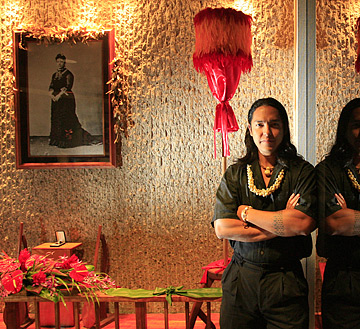[INSIDE HAWAII INC.]

JAMM AQUINO / JAQUINO@STARBULLETIN.COM
Wes Kaiwi Nui is the director of cultural affairs at the Royal Hawaiian Shopping Center in Waikiki and in charge of all cultural events and activities.
|
|
New director brings culture to Royal Hawaiian center
The Kamehameha grad will make sure the renovated complex will be sensitive to native Hawaiian history
Question: What is the cultural aspect of the center?
Answer: It's land, first, and what I think we all have to realize is this land is tied to a legacy. It's no mystery that Kamehameha Schools owns the land. But there's a legacy here, a descendancy from the chiefs all the way down to the native Hawaiian children of today. We want to keep this place pono and enhance that. We have to respect what was here before. Everything is designed around the Royal Grove (a new cultural gathering place at the center.)
WES KAIWI NUI
» New job: Wes Kaiwi Nui has been named director of cultural affairs at the Royal Hawaiian Shopping Center in Waikiki. He works for the center's manager, the Los Angeles-based Festival Cos.
» Job description: The center is undergoing a more than $84 million renovation, to be completed next year, and Kaiwi Nui works with Royal Hawaiian management to make sure the property's new look and marketing is sensitive to its place in native Hawaiian history.
» Background: He has practiced architecture for 10 years and is a 1993 graduate of the Kamehameha Schools, which owns the shopping center. He is a student of "lua," or traditional Hawaiian martial arts, strategy and healing.
» Age: 30.
|
I can go to Los Angeles or New York, but what is it about it that makes this place special, and that is its culture. It's what distinguishes us from the world.
Q: What's an example of what you do in the project?
A: I work with the marketing director as well as the operations manager as well as Kamehameha Schools. I'm in the middle of all of it. Let's say something as simple as: We do want to have the statue of Princess Pauahi in the grove. Operations needs to know what is the maintenance of this, what are our costs. Marketing wants to know how do we respectfully and with dignity market this for the schools. We never walk behind our ali'i. If our ali'i is seated, then we can sit. There is a cultural protocol for how we can do this and where. You just have to have patience and know how to do it.
Q: How do you decide what is right?
A: First and foremost, no one man answers for Hawaiian culture. I'm just a grain of sand on the beach. Native Hawaiian 'aumakua always give great guidance. In my case, that manifestation is through lua and the 'olohe who are masters of lua. In my case, the 'olohe is Mitchell Eli. Hawaiian people are very spiritual. What is really right? If our intention is really pure and there is no malice to our surroundings, then I think we're on the right track.
Q: What will be your job when the renovation is done?
A: All that means is that development drops off my table and I will still work with marketing and operations and Kamehameha, because one of the things I'd like to do is increase our programs tremendously because there is much more to Hawaiian culture than lei making, quilting and hula. There's navigation. There's kapa making. There's kahili making. There's so much about our culture that has yet to be revealed to our guests. Part of the challenge is not so much coming up with the programs. The challenge would be how do we fund our programs. These programs are free to our guests because our main mission is to teach our guests.
Part of my push is to have a docent program with the Kamehameha kids to come back to Helumoa and lead as docents. Who better to share our culture than Hawaiian children. I think it's important that our guests get that and it is the very best we can give.
Q: What Oahu building exemplifies good architecture for Hawaii?
A: The finest piece of architecture in Hawaii, and it's probably indisputable to everyone, is Hawaii itself. There is no equal to that. My focus is always on land first. After that it's "built environment." Some examples of built environment are the preschool above the Department of Planning and Permitting. It's built on top of the structure. A lot of people don't know that it's there, in the middle of downtown, and that's great.
Inside Hawaii Inc. is a weekly conversation with business and community leaders. Suggestions can be sent to
business@starbulletin.com.

